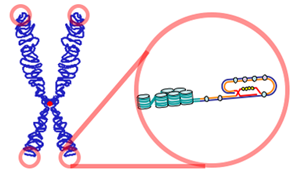Ring chromosome 15
Editor-In-Chief: Prab R Tumpati, MD
Obesity, Sleep & Internal medicine
Founder, WikiMD Wellnesspedia &
W8MD medical weight loss NYC and sleep center NYC
| Ring chromosome 15 | |
|---|---|

| |
| Synonyms | N/A |
| Pronounce | N/A |
| Specialty | N/A |
| Symptoms | Growth retardation, developmental delay, intellectual disability, microcephaly, facial dysmorphism |
| Complications | Seizures, congenital heart defects |
| Onset | Congenital |
| Duration | Lifelong |
| Types | N/A |
| Causes | Genetic mutation |
| Risks | Parental chromosomal rearrangement |
| Diagnosis | Karyotype analysis, genetic testing |
| Differential diagnosis | Other chromosomal disorders |
| Prevention | N/A |
| Treatment | Supportive care, symptomatic treatment |
| Medication | N/A |
| Prognosis | Variable, depends on severity |
| Frequency | Rare |
| Deaths | N/A |
Ring chromosome 15 is a rare human chromosomal abnormality where the two arms of chromosome 15 have fused to form a ring. This condition is characterized by developmental delay, growth retardation, and characteristic facial features.
Characteristics[edit | edit source]
Individuals with ring chromosome 15 often exhibit developmental delays, growth retardation, and characteristic facial features. These features may include a small head (microcephaly), a prominent nose, a thin upper lip, and a small jaw (micrognathia). Other features can include heart defects, kidney abnormalities, and seizures.
Causes[edit | edit source]
Ring chromosome 15 is caused by a deletion in the short (p) and long (q) arms of chromosome 15. This deletion results in the formation of a ring chromosome. The size of the deletion varies among affected individuals and can influence the severity of the condition.
Diagnosis[edit | edit source]
Diagnosis of ring chromosome 15 is typically made through genetic testing, which can identify the characteristic ring structure of the chromosome. This testing can be done through a blood sample.
Treatment[edit | edit source]
There is currently no cure for ring chromosome 15. Treatment is symptomatic and supportive, focusing on managing the individual symptoms and complications of the condition. This can include physical therapy for developmental delays, medication for seizures, and surgery for heart or kidney abnormalities.
See also[edit | edit source]
References[edit | edit source]
Search WikiMD
Ad.Tired of being Overweight? Try W8MD's physician weight loss program.
Semaglutide (Ozempic / Wegovy and Tirzepatide (Mounjaro / Zepbound) available.
Advertise on WikiMD
|
WikiMD's Wellness Encyclopedia |
| Let Food Be Thy Medicine Medicine Thy Food - Hippocrates |
Translate this page: - East Asian
中文,
日本,
한국어,
South Asian
हिन्दी,
தமிழ்,
తెలుగు,
Urdu,
ಕನ್ನಡ,
Southeast Asian
Indonesian,
Vietnamese,
Thai,
မြန်မာဘာသာ,
বাংলা
European
español,
Deutsch,
français,
Greek,
português do Brasil,
polski,
română,
русский,
Nederlands,
norsk,
svenska,
suomi,
Italian
Middle Eastern & African
عربى,
Turkish,
Persian,
Hebrew,
Afrikaans,
isiZulu,
Kiswahili,
Other
Bulgarian,
Hungarian,
Czech,
Swedish,
മലയാളം,
मराठी,
ਪੰਜਾਬੀ,
ગુજરાતી,
Portuguese,
Ukrainian
Medical Disclaimer: WikiMD is not a substitute for professional medical advice. The information on WikiMD is provided as an information resource only, may be incorrect, outdated or misleading, and is not to be used or relied on for any diagnostic or treatment purposes. Please consult your health care provider before making any healthcare decisions or for guidance about a specific medical condition. WikiMD expressly disclaims responsibility, and shall have no liability, for any damages, loss, injury, or liability whatsoever suffered as a result of your reliance on the information contained in this site. By visiting this site you agree to the foregoing terms and conditions, which may from time to time be changed or supplemented by WikiMD. If you do not agree to the foregoing terms and conditions, you should not enter or use this site. See full disclaimer.
Credits:Most images are courtesy of Wikimedia commons, and templates, categories Wikipedia, licensed under CC BY SA or similar.
Contributors: Prab R. Tumpati, MD




